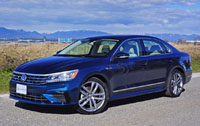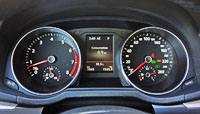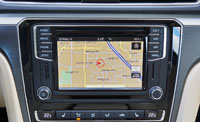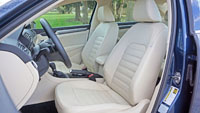
Thank you Volkswagen. You’ve made my job so much easier today. While researching the 2019 Passat for this review, I learned that it’s only available in a single, solitary, one-size-fits-all trim line for this stopgap year, the Wolfsburg Edition getting very close to last year’s top-tier Passat Highline (which replaced the Execline from 2016). This allows me to spend more time on other details such as styling, cabin quality, comfort, driving dynamics, etcetera.
The Giorgetto Giugiaro-designed Passat (originally named Dasher in our market) has been with us since 1973, initially delivering an upscale Audi-inspired look in five-door hatchback and wagon body styles, the former replaced by a regular sport/luxury sedan dubbed for its second B2 generation. The B3 redesign that arrived in 1988 finally applied the Euro nameplate to North American models, and while I really liked this third-gen Passat, particularly in its most potent VR6 trim, as well as the B4 that followed, my heart went out to the 270 hp 4.0-litre W8-powered AWD B5 version most earnestly. Earlier B5s were also the first Passats I tested as an automotive journalist newbie in the early 2000s, back when this German brand impressed me like no other.
That was a time when Volkswagen was comparable to Audi for its performance and overall refinement, the amazing Bentley-based Phaeton luxury sedan arriving the following year with a choice of 335-horsepower V8 or 420-horsepower W12 behind its unassuming grille, not to mention $96,500 and $126,790 respective prices, while not long after that the brand’s 309-hp Touareg V10 TDI was on the scene, putting out a shocking 553 lb-ft of torque. Volkswagen appeared to be vying for luxury brand status during those years, a strategy that kind of made sense in Europe where parent automaker VW AG also owned lesser brands Skoda and Seat to pull in entry-level buyers, but not here where the iconic Beetle manufacturer was known more for economy cars.

By comparison, today’s VW-branded cars and crossover SUVs still deliver some premium features not often available with every competitor, like cloth-covered roof pillars (albeit only the A pillars these days), full high-definition TFT primary gauge clusters, and the convenience of a rear seat centre pass-through for stowing long cargo (or better yet, 40/20/40 split-folding rear seats), soft pliable composite surfaces aren’t as plentiful, switches, knobs and buttons can now be less dense and therefore cheaper feeling, and rear suspension systems aren’t necessarily independent anymore (unlike most rivals that are now IRS-equipped, the latest Jetta has reverted to using a rear torsion beam setup).
I think the Passat looks good though, particularly in my tester’s attractive Tourmaline Blue Metallic. It’s one of six exterior paints for 2019, which include white, black, grey and silver, plus a beautiful Fortana Red Metallic, all no-cost options, while sporty R-Line outer trim comes standard this year too. Additional standard features include automatic on/off LED headlights with LED daytime running lamps, LED tail lights, and fabulous looking silver-painted twinned five-spoke 19-inch Salvador alloy wheels encircling 235/40 all-seasons, and that’s just on the outside.
To my eyes the cabin looks even better due to VW’s communications team choosing gorgeous Cornsilk Beige for my test car’s interior (it can be had in black or grey as well, depending on the exterior colour chosen), the creamy colour offset by a contrasting black dash top, door uppers and carpets. VW has been producing this rich light beige and black interior motif for decades, including the horizontal ribbing on the leather seat upholstery. It looks sensational, complemented by sophisticated looking textured metal, brushed aluminum, chrome and piano black lacquer elsewhere.

Standard features include proximity keyless entry with pushbutton start/stop, a leather-wrapped multifunction steering wheel rim with shift paddles, a colour multi-information display/trip computer, a leather-wrapped shift knob and handbrake lever, brushed stainless steel foot pedals, rain-sensing windshield wipers, heatable washer nozzles, two-zone automatic climate control, an auto-dimming centre mirror, a power sunroof, three-way heated front sport seats, an eight-way powered driver seat with two-way power lumbar, driver’s side memory, heatable rear seats, front and back LED reading lamps, an Easy Open trunk, 60/40-split rear seatbacks with a centre armrest and centre pass-through, plus more for $32,995.
That seems like a reasonably good deal already, but it gets better due to a $2,000 no-haggle discount that comes as a parting gift of sorts. Find out about this discount and any other rebates right here at CarCostCanada, and while you’re learning more you can also access dealer invoice pricing, which will make it as easy as possible to meet your budget requirements.
I should also go into some detail about the Passat’s infotainment system, which measures 6.33 inches and even includes proximity sensing, which means a row of digitized buttons rise up from the bottom of the touchscreen when your fingers get near. While the display is relatively small compared to most competitors’ top-line systems, it process info quickly, includes tablet-style tap, swipe and pinch gesture functions, which are especially useful when using the route guidance-system’s map, and even includes MirrorLink smartphone integration, along with the usual Apple CarPlay and Android Auto. Bluetooth is also standard, of course, with audio streaming for listening to music or podcasts from your personal device, while additional standard infotainment features include voice activation, an SD card slot, and one of the worst backup camera systems I’ve used in a long time. Why? Much of the display’s top section was cut off in a semicircular due to a wide-angle lens that was probably trying to provide more visibility, but it actually made things a lot worse, plus VW didn’t include active guidelines either.

The six-speaker Fender premium audio system is good enough for this class, however, with nice deep bass from its subwoofer, while satellite radio stations came in clearly, the inclusion of a CD player will be appreciated by many, and the single USB audio/charging port made me grateful VW wasn’t still trying to promote Apple, although I’m hoping the next-generation has a few more. Speaking of new, the I hopped into the latest 2020 GTI after giving the Passat keys back and am now hopeful that its considerably larger touchscreen, along with its superb resolution and excellent depth of contrast and colour make it into the 2020 Passat, or something similar.
Moving downward on the centre stack, past the HVAC interface that incidentally suffered from loose rotating dials, there’s a lidded compartment for stowing and charging a smartphone. It has a rubberized base, like usual, but oddly it wasn’t big enough for my average-sized phone, which kind of made me glad VW hadn’t installed a wireless charging pad. It did include the just noted USB-A port and as well as an auxiliary connection next to an old-school 12-volt plug, so you should be able to charge multiple devices at any given time (with the help of an aftermarket USB adapter).
Close by, to each side of the shift lever, is a row of “buttons”, or at least they all look like buttons. One deactivated the front and rear parking sonar, while another turned on the semi-autonomous self-parking system, but the other four were merely dummy buttons that made the car look as if it was missing some key features. I noticed it was devoid of a heatable steering wheel, something I appreciate on cold winter mornings, a problem made worse when the flat-bottom leather-wrapped sport steering wheel in question is so incredibly good. The front seats weren’t ventilated either, a function I’m getting more and more used to finding in top-line competitors’ trims.

The Passat’s standard menu of safety enhancements impresses, however, with items like automatic emergency braking, blind spot monitoring with rear cross-traffic warning, lane keeping assist, adaptive cruise control, driver assistance, park distance control and park assist adding enough high technology to the driving experience as to almost forget about those missing buttons. Better yet, the way these systems chose not to intervene until absolutely necessary had me liking the Passat even more. No one likes over-sensitive technology, especially with respect to safety equipment capable of taking over the wheel, and fortunately the Passat’s were hardly noticeable throughout my test week. It was only when I tried to exit the highway without using my turn signal that the side-assist system fixated on the white line, pulling me back into my lane. I quickly turned my blinker on and was able to move over, and no doubt could have forced it over if I’d wanted to, but VW gets high marks for making advanced driver assistance systems that are only there when absolutely necessary.
Previously in this review I mentioned that Volkswagen’s cabin materials aren’t as high in quality now as they used to be, so I should probably go into some more detail about how this affects the Passat. For the most part it’s equal to most competitors, but this makes the car seem less than ok being that it was much better than average years ago. Right up until this US-made seventh-generation model arrived nine years ago, the Passat provided a much greater percentage of premium-level soft padded surfaces than any rival, but now it’s noticeably below average. It’s as if VW AG, the parent company, didn’t want its namesake brand stealing any sales from Audi, so therefore purposely made the Passat’s interior worse than it needed to be, just to be sure. To be clear, some parts are extremely good, like the soft composites used for the dash top and door uppers, but the lower dash panels and glove box lid, plus the centre stack sides and lower door panels are made from lower grade hard plastics, and upstaged by most competitors. This leaves some areas better than average and others not quite measuring up, and depending on whether you see your glass half full or half empty, you’ll either be thrilled with all that’s good or left feeling flat about the car’s weaknesses.

I felt much the same about the Passat’s sole 2.0-litre four-cylinder engine. Its 174 horsepower and 184 lb-ft of torque comes close to matching most rivals’ base powerplants, but it’s hardly a base model despite the aforementioned discount. Last year’s 3.6-litre V6 upgrade provided an option for those wanting more, but no such luck for this year’s performance fans. Fortunately its modest torque figure feels stronger than it looks, probably due to arriving at its maximum at only 1,500 rpm, so takeoff is fairly energetic off the line and there’s ample passing power for most manoeuvres, but a model that once offered 4Motion all-wheel drive now solely gets driven by those up front, and the transmission that sends the engines output to the front wheels only has six forward speeds, which might have been a big deal fifteen years ago, but doesn’t sound all that advanced when put up against today’s eight- and nine-speed automatics.
The 2020 Passat will remedy the latter problem with an eight-speed of its own, but no AWD or manual transmission for that matter, two features enthusiasts would love to see, but the current model’s paddle shifters got everything out of the engine it had to give, just like the future one will make the most of even more available torque, resulting in a really enjoyable car to drive.
I appreciated the extra control, because this mid-size family hauler can dance with more grace than most four-door sedans in this class, even at high speeds. Of course its suspension is fully independent, with struts up front and a multi-link setup in back, plus a stabilizer bar at each end, and it’s all very well sorted for a bit more grip at the limit and better balance than the segment average. It will understeer when pushed too far, which is a good thing in this category, and its ride should keep all aboard happy, despite being slightly firmer than average.

Fuel-efficiency is quite good at 9.3 L/100km city, 6.5 highway and 8.1 combined, no doubt why Volkswagen chose the four-cylinder for this model’s sole power unit in place of the V6. Such practicality in mind, you won’t need to worry about anything that might go wrong with the Passat for a year longer than most rivals thanks to an almost comprehensive four-year or 80,000 km warranty, although it’s powertrain warranty is shorter than average by a year or 20,000 km.
Now that we’re being pragmatic, the Passat’s front seats and surrounding area is amply roomy for big folks, while the driver’s seat is comfortable, but like the suspension it’s a bit firmer than most in this class. It features two-way powered lumbar support that just so happened to ideally match up to the small of my back, while its lower cushion stretched forward enough to support nicely below the knees.
The rear seating compartment is roomier still, and plenty comfortable, while a 450-litre (15.9 cubic-foot) trunk should be more than adequate for most owners’ needs, especially when considering its 60/40 split-folding rear seatbacks have the advantage of a centre pass-through for loading in longer items like skis.

These are some of the 2019 Passat’s worthy attributes that I hope are carried forward into the new model, but in the same breath I’m also wishing Volkswagen steps up with more competitive interior quality so that it at least matches the refinement of this segment’s sales leaders. After all, it’s the slowest selling mid-size four-door sedan in Canada by a long shot, so arriving in today’s highly competitive marketplace with a lukewarm update wouldn’t be the best of ideas. Let’s hope they get it right. Until then, the 2019 Passat does some things very well and others not so much, but it’s currently priced right and the deal could be made even sweeter by finding out its dealer invoice price here on CarCostCanada before talking to your local Volkswagen retailer.
Story and photo credits: Trevor Hofmann
